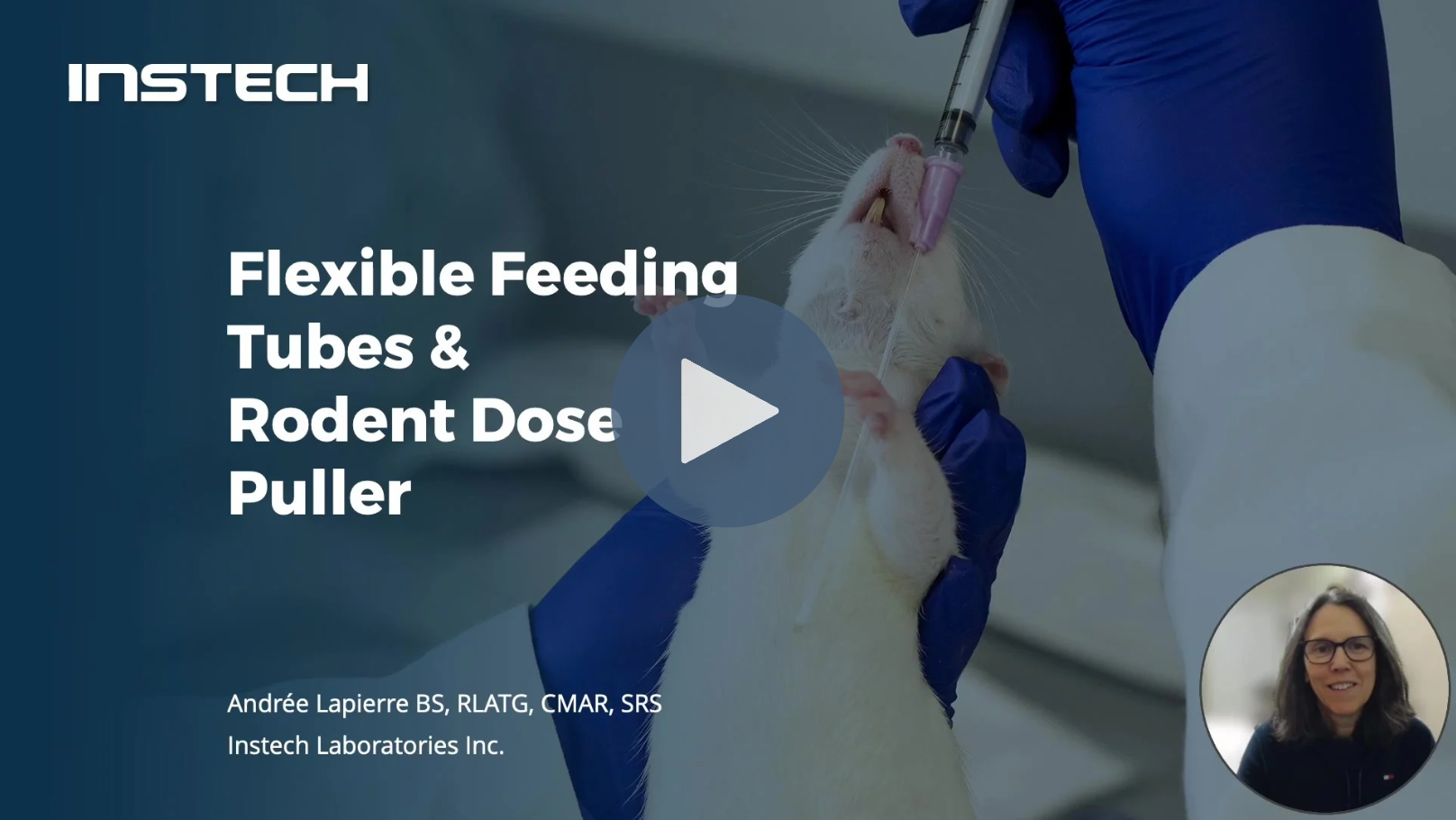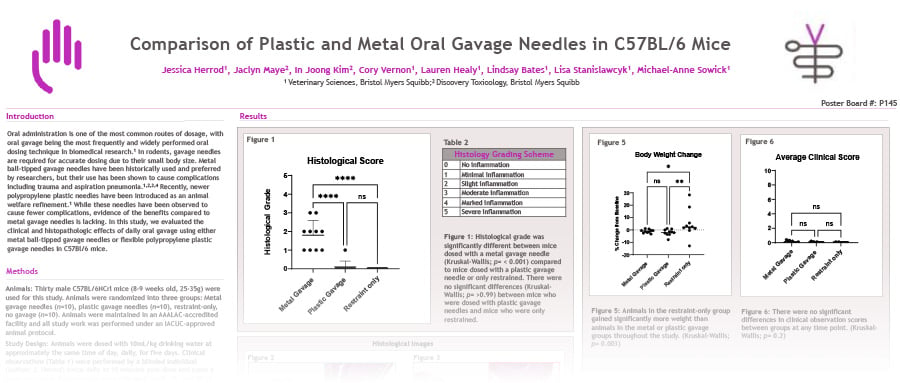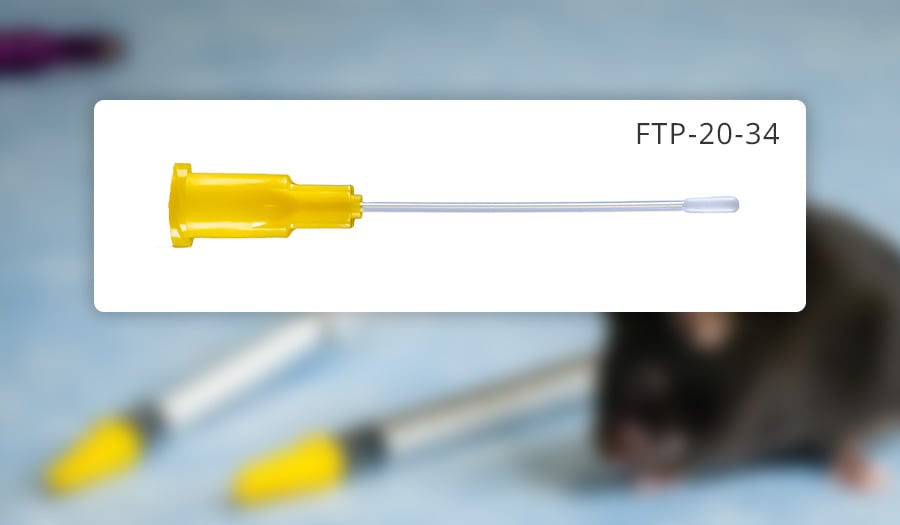Everything you need to know about using flexible feeding tubes for rodents
Table of Contents:
- What is a Flexible Plastic Feeding Tube?
- Stainless Steel vs. Flexible Plastic Feeding Tubes - Which Should You Use?
- Do You Need a Bite Guard on a Plastic Tube?
- What Size Feeding Tube Should You Use?
- How to Scruff a Mouse or Rat for Oral Dosing
- How to Administer Compounds by Oral Gavage in Mice and Rats
- Where Can You Get Trained on How to Use Plastic Feeding Tubes?
- Are You Conducting Large-Scale Rodent Dosing Studies?
- How Can You Try Them Before You Buy Them?
What is a Flexible Plastic Feeding Tube?
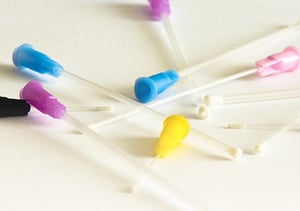 Plastic feeding tubes, or flexible plastic feeding needles, are exactly as they sound. Rather than the traditional rigid stainless steel feeding tubes that researchers have been so accustomed to over the years, flexible feeding tubes are made from medical-grade polypropylene (the same material used in plastic syringes). There is a plastic hub that securely attaches to your syringe via luer lock or slip fit, then a long flexible tube of varying lengths and widths that ends in a soft rounded bulbous tip that gently delivers the material into the animal.
Plastic feeding tubes, or flexible plastic feeding needles, are exactly as they sound. Rather than the traditional rigid stainless steel feeding tubes that researchers have been so accustomed to over the years, flexible feeding tubes are made from medical-grade polypropylene (the same material used in plastic syringes). There is a plastic hub that securely attaches to your syringe via luer lock or slip fit, then a long flexible tube of varying lengths and widths that ends in a soft rounded bulbous tip that gently delivers the material into the animal.
Being made from polypropylene, these feeding tubes offer a few advantages. Most importantly, they’re safer for the animal, and a recommended animal welfare refinement. The elastomer tip minimizes the chance of inadvertent placement in the trachea, a common dosing problem. They’re also disposable and meant for single use. Once you’re done, just throw them away. No need to clean and autoclave, no risk of carryover contaminant.
Stainless Steel vs. Flexible Plastic Feeding Tubes - Which Should You Use?
When it comes to the world of oral gavage, the universe is divided into two camps: those who trained on and continue to use stainless steel, and those who use flexible plastic. If you’re a stainless steel user, should you use curved or straight? Disposable metal? Should you convert to a flexible plastic? If you’re just beginning to gavage, which path is right for you? What is best for the animal? Which is easiest to use? Recent studies, like this one from BMS, show clear evidence in favor of flexible plastic. Still unsure? This post takes a deep dive into both
Do You Need a Bite Guard on a Plastic Tube?
When you first switch to plastic feeding tubes, you may encounter some instances when the mouse or rat bites the tube. This can be scary; if the tube has been bitten off completely and you do not act fast you may even need to euthanize the animal. It’s understandable to want to change the product to add a bite guard, or give up altogether and switch back to metal, but is this really the right thing to do? Let’s take a look
What Size Feeding Tube Should You Use?
There are some general guidelines to follow based on body weight and compound viscosity for both mice and rats, but there isn’t an exact science. You’ll need to try out a few different sizes and see what works best for you. Depending on the compound, body weight and esophageal length of the animal, one size may suit you better than another.
Length
For determining length, the tube should be equal to the length from the bottom of the mouth to the sternum (see photo). The right length helps prevent aspiration as well as perforation.
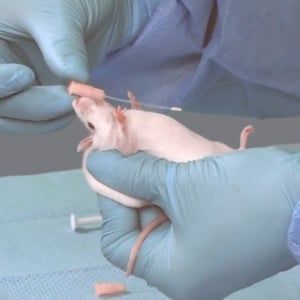
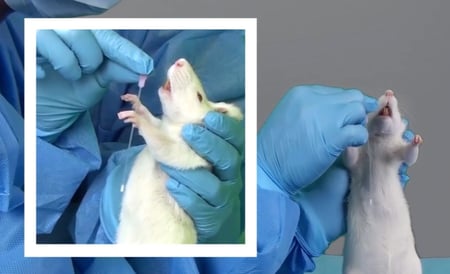
Gauge
The preferable gauge is dependent on the size of the rodent and the viscosity of the dosing compound.
Size Options and Recommendations
Mouse < 20g
- FTP-22-25 (black)
Mouse 20-30g
- FTP-20-30 (yellow)
- FTP 20-34 (yellow)
Mouse > 30g
- FTP 20-38 (yellow) - most common size for mice
- FTPU 16-38 (polyurethane) - good for viscous solutions
Rat < 100g
- FTP-18-30 (pink)
- FTP-22-38 (black)
Rat 100-200g
- FTP 18-38 (pink)
- FTP 18-50 (pink)
- FTP 15-64 (blue)
Rat 200-300g
- FTP 18-75 (pink)
- FTPU 13-88 (polyurethane)
- FTPU C9-85 (polyurethane)
Rat > 300g
- FTP 15-78 (blue)
- FTP 15-100 (blue)
Large Rodents
- FTP 13-90 (pink)
- FTP 13-50 (pink)
Download the feeding tube brochure to see full-size and specifications listings for all feeding tubes.
See feeding tube pricing and request a quote
How to Scruff a Mouse or Rat for Oral Dosing
Proper restraint is the most important step of any gavage procedure. Before giving an oral dose to any rat or mouse, it’s important to spend some time handling them beforehand. The more you handle and play with them, the more relaxed they will be when it comes time to scruff and dose. This helps make the whole process easier for both you and the animal.
Mice
Gently but firmly grasp the mouse by the base of the tail. Then use the thumb and index finger to gently grasp the nape of the neck. You may use your middle finger to stabilize the head. Once you have a good grasp, lift the mouse and hold in an upright position freeing the legs from the bench surface. The mouse should appear comfortable, judged my monitoring respiratory rate that is within normal limits.
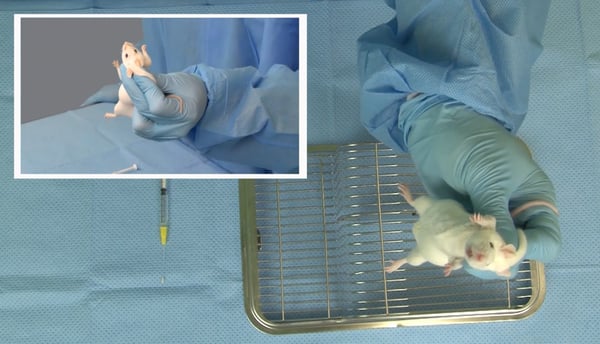
Alternatively, you can employ a two-handed technique that lifts the tail with one hand while the nape of the neck is scruffed by the other hand as shown in the first technique.
Watch How to Scruff a Mouse
Rats
Gently and firmly grasp the rat at the nap of the neck between the thumb and forefinger.
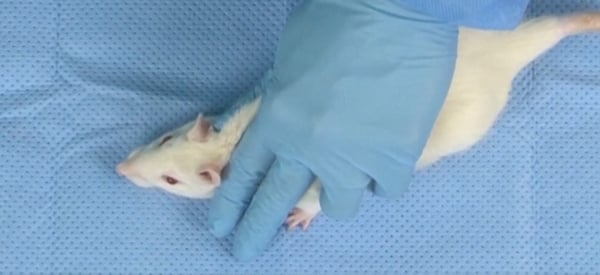
Lift the rat by the scruff and confidently hold in an upright position so the rat cannot use its back legs for leverage.
Watch How to Scruff a Rat
How to Administer Compounds by Oral Gavage in Mice and Rats
Dosing Techniques with Mice and Rats
After scruffing the rodent, the feeding tube should be inserted to the right or the left of midline. Doing so reduces the chance the mouse or rat can bite the tube. Little to no resistance should be felt — if you do feel some resistance, you may have accidentally entered the trachea. If you notice fluid bubbling from the nose, stop administration immediately. This is an indicator of aspiration. Move swiftly but carefully, and be sure to empty the entire syringe before removing. Be sure to monitor the animal after dosing to make sure breathing remains within normal limits.
Watch How to Give a PO Dose to a Mouse
Watch How to Give a PO Dose to a Rat
Where Can You Get Trained on How to Use Plastic Feeding Tubes?
Training with plastic feeding tubes is faster and easier for new hires. If you’re a trainer, switching to flexible plastic is not only better for the animal, but better for your students, and you. We’ve developed two training videos to help get you started. As with any new skill, practice makes perfect. But if you stick with it, you’ll reap the benefits:
How to Oral Gavage a Rat with Flexible Plastic Feeding Tubes
How to Oral Gavage a Mouse with Flexible Plastic Feeding Tubes
Are You Conducting Large-Scale Rodent Dosing Studies?
A result of a multi-year development effort in collaboration with a large contract research organization, The Rodent Dose Puller protects technicians, reduces dose error, and speeds up the dosing process. Rodent dosing studies at scale demand efficiency, accuracy, and safety for both the animal and the technician.
Designed to integrate directly with a LIMS connection, CSV file upload, or by manual entry, the Rodent Dose Puller (RDP):
- Protects technicians by eliminating the chance of thumb injury, and fatigue
- Reduces dose error by roughly 50%
- Speeds up the dosing process by approximately 15%
Frothy solutions, viscous solutions, and a wide range of compatible syringe sizes, the RDP is a dramatic improvement for large-scale rodent dosing studies. Learn more here
How Can You Try Them Before You Buy Them?
We are happy to make recommendations on sizes based on body weight from the chart above, but this isn't an exact science - it can be helpful to try a few different sizes and see what works best for you. We provide free feeding tube samples to help get you started. Request yours here
